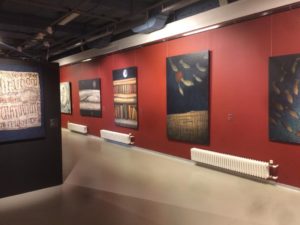Freedom from Being Relevant, personal exhibition of Sergei Sergeyev in the ERARTA Museum, St. Petersburg 02.03.2022-05.06.2022
Sergey Sergeyev’s half-century creative career looks impressive and quite befitting a St. Petersburg based painter: apartment exhibitions of the Leningrad underground artists, religious and mystical quests within Alipius artist collective, and a breakthrough to a wider audience as part of the Society for Experimental Visual Art (TEII). Riding the wave of enthusiasm for Soviet art, Sergeyev took part in international exhibitions which secured him final and definitive recognition in Russia and cemented his union with D-137, one of the city’s first art galleries. As fate would have it, the artist has always been the trailblazer of the creative avant-garde, actively involved in everything that was happening for the first time or against all odds.
In the past two decades, brandishing the motto of ‘Freedom from Being Relevant,’ he has not, however, lost any of his innate interest in observation. Running parallel to the stellar track record of a successful painter whose works are ‘in major collections in Russia and abroad,’ there is Sergey Sergeyev’s private journey, full of landmark meetings and arresting visions, gradually acquiring a mythical quality. A full-time observer today, he was once employed as a mountain ‘snow record keeper’ and used to listen to the music of the spheres at the Crimean Astrophysical Observatory in the company of Brian Eno. Sergeyev’s principal link to modernity is through music, although his works hardly allow one to identify him as a passionate audiophile and record collector, equally interested in vinyl, audio tapes from the times of the Leningrad Rock Club, and rare CDs released solely for the benefit of hardcore fans. The realm of sound, specifically such product of the retro pop culture and romantic aestheticism as new wave music, defined one of the major themes explored by the artist.
Interestingly enough, Sergeyev enjoys his ‘Freedom from Being Relevant’ while being inspired by three subjects that were erstwhile trendsetting and incredibly popular – in other words, relevant. As his interest in new wave subsided, the artist turned to the image of palimpsest – a parchment scroll from which the previous text has been scraped or washed off but is still visible below the new one. This archaeological phenomenon serves as an apt metaphor for the mid-to-late 20th-century art. Each painting from the Palimpsests series is a vision of a text written in all the world languages at once and not meant to be read. Most of Sergey Sergeyev’s paintings testify to the existence of a universal language, the logos from which all things originate. Ungraspable to man, it can be recognised in the sounds of music, written signs, or the voice of nature.
Sergeyev’s next extensive series of paintings, Captcha, continues to explore the subject of man as the bearer of the divine spark of language. Captcha (the Completely Automated Public Turing test to tell Computers and Humans Apart) has become a part of our everyday life. We owe the emergence of this mildly amusing routine to a philosophical question: can machines think? The rise of self-learning artificial intelligence became one of the challenges of the very relevant reality from which Sergeyev the artist claims to be free. Perhaps an even more urgent question would be: what does it mean to be human? Before we even knew it, we found ourselves convincing machines of our right to be considered human by typing a number of distorted symbols in a dialogue box several times a day.
Jokes about this abound among the Internet lore: ‘Degradation is when captcha becomes the message,’ ‘Postmodernism is captcha being considered a finished literary work,’ ‘Artistic freedom is captcha that has spaces for self-expression,’ ‘Enlightenment is realising what every character of kaptcha stands for,’ etc.
Sergey Sergeyev’s many-layered painting style turns semblances of signs – calligraphic fantasies imitating letter-based kaptchas – into palimpsest manuscripts in which meanings eagerly await an attentive human eye. Postmodernists cut and pasted their bizarre novels and blockbusters using easily recognisable references – it was the ability to spot them that made the dialogue with these creations pleasurable. Nowadays, the ‘irrelevantly free’ artist Sergey Sergeyev offers us his works feigning computer-generated text as a test to determine whether we are still human.
By Pavel Markaitis